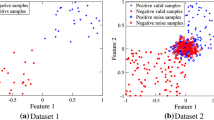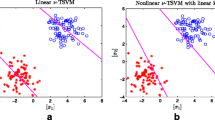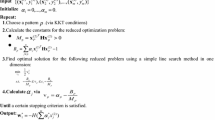Abstract
In this paper, for an improved twin support vector machine (TWSVM), we give it a theoretical explanation based on the concept of Universum and then name it Self-Universum support vector machine (SUSVM). For the binary classification problem, SUSVM takes the positive class and negative class as Universum separately to construct two classification problems with Universum; therefore, two nonparallel hyperplanes are derived. SUSVM has several improved advantages compared with TWSVMs. Furthermore, we improve SUSVM by formulating it as a pair of linear programming problems instead of quadratic programming problems (QPPs), which leads to the better generalization performance and less computational time. The effectiveness of the enhanced method is demonstrated by experimental results on several benchmark datasets.


Similar content being viewed by others
References
Cortes C, Vapnik VN (1995) Support-vector networks. Mach Learn 20(3):273–297
Vapnik VN (1998) Statistical learning theory. Wiley, New York
Weston J, Collobert R, Sinz F, Bottou L, Vapnik V (2006) Inference with the universum. ICML ’06. In: Proceedings of the 23rd international conference on machine learning, pp 1009–1016
Cherkassky V, Dhar S, Dai W (2011) Practical conditions for effectiveness of the universum learning. IEEE Trans Neural Netw 22:1241–1255
Shen C, Wang P, Shen F, Wang H (2001) Uboost: boosting with the universum. IEEE Trans Pattern Anal Mach Intell 34:825–832
Mangasarian OL, Wild EW (2006) Multisurface proximal support vector classification via generalized eigenvalues. IEEE Trans Pattern Anal Mach Intell 28(1):69–74
Jayadeva RK, Khemchandani R, Chandra S (2007) Twin support vector machines for pattern classification. IEEE Trans Pattern Anal Mach Intell 29(5):905–910
Kumar MA, Gopal M (2008) Application of smoothing technique on twin support vector machines. Pattern Recognit Lett 29(13):1842–1848
Khemchandani R, Jayadeva RK, Chandra S (2009) Optimal kernel selection in twin support vector machines. Optim Lett 3(1):77–88
Kumar MA, Gopal M (2009) Least squares twin support vector machines for pattern classification. Expert Syst Appl 36(4):7535–7543
Shao YH, Zhang CH, Wang XB, Deng NY (2011) Improvements on twin support vector machines. IEEE Trans Neural Netw 22(6):962–968
Peng XJ (2010) Tsvr: an efficient twin support vector machine for regression. Neural Netw 23(3):365–372
Chen X, Yang J, Ye Q, Liang J (2011) Recursive projection twin support vector machine via within-class variance minimization. Pattern Recognit. doi:10.1016/j.patcog.2011.03.001
Qi ZQ, Tian YJ, Shi Y (2012) Laplacian twin support vector machine for semi-supervised classification. Neural Netw 35:46–53
Qi ZQ, Tian YJ, Shi Y (2012) Twin support vector machine with universum data. Neural Netw 36:112–119
Qi ZQ, Tian YJ, Shi Y (2013) Robust twin support vector machine for pattern classification. Pattern Recognit 46:305–316
Qi ZQ, Tian YJ, Shi Y (2013) Structural twin support vector machine for classification. Knowl Based Syst 43:74–81
Tian YJ, Shi Y, Liu XH (2012) Recent advances on support vector machines research. Technol Econ Dev Econ 18:5–33
Tian YJ, Ju XC, Qi ZQ (2013) Efficient sparse nonparallel support vector machines for classification. Neural Comput Appl. doi:10.1007/s00521-012-1331-5
Tian YJ, Qi ZQ, Ju XC, Shi Y, Liu XH (2013) Nonparallel support vector machines for pattern classification. IEEE Trans Cybern. doi:10.1109/TCYB.2013.2279167
Platt J (2000) Fast training of support vector machines using sequential minimal optimization. In: Schölkopf B, Burges CJC, Smola AJ (eds) Advances in kernel methods—support vector learning. MIT Press, Cambridge
Angulo C, Parra X, Catala A (2003) K-svcr a multiclass support vector machine for multi-class classification. Neurocomputing 55:57–77
Acknowledgments
This work has been partially supported by grants from National Natural Science Foundation of China (Nos. 11271361, 71331005), Major International (Ragional) Joint Research Project (No. 71110107026), the Ministry of water resources’ special funds for scientific research on public causes (No. 201301094).
Author information
Authors and Affiliations
Corresponding authors
Rights and permissions
About this article
Cite this article
Liu, D., Tian, Y., Bie, R. et al. Self-Universum support vector machine. Pers Ubiquit Comput 18, 1813–1819 (2014). https://doi.org/10.1007/s00779-014-0797-9
Received:
Accepted:
Published:
Issue Date:
DOI: https://doi.org/10.1007/s00779-014-0797-9




